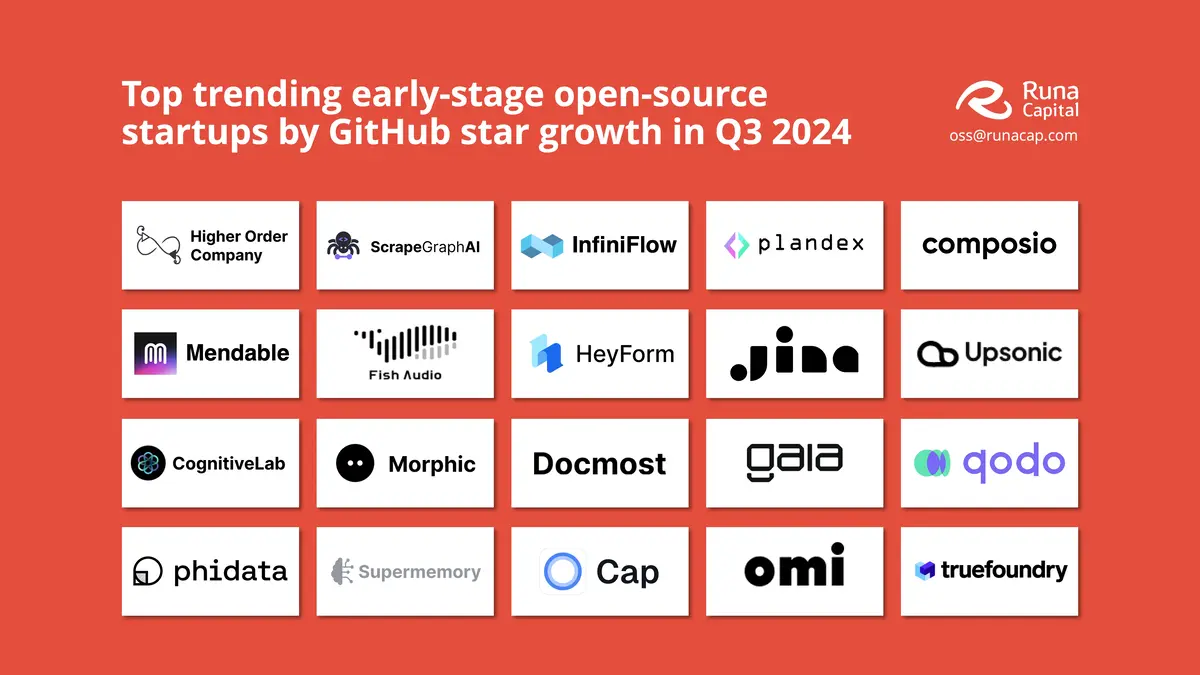More than half of the top-trending open source startups around the world are closely related with AI features. Thanks to a recent report by European venture capital firm Runa Capital, you can learn which the hottest startups are nowadays.
Runa Open Source Startup Index has operated since 2020 and it serves as a quarterly update on fastest-growing projects using the GitHub “stars” metric. It’s an element that works like a hearth or thumb-up on social media platforms. Since 2023, Runa produces annual reports to highlight the most popular commercial open source startups of every year. Here you can find the 20 hottest startups of 2024.
AI and Data infrastructure are the hottest startups theme
The pole position belongs to LangChain with an open source framework for building LLM-centric apps. AI is at the core of the startups with 11 of 20 companies working something related to Artificial Intelligence tools and features.
The ROSS Index is strictly curated and doesn’t include any old open source project. The qualifying project must be closely linked to commercial companies meaning there’s no side project attaced. Additionaly, the companies must be younger than 10 years old. Funding can’t surpass $100 million and it must be fully independent to avoid subsidiaries or publicly listed ones.
Stargazing the hottest startups
Ollama is the top spot 2024 ROSS Index company. It’s a Y Combinator alum that created an open source tool to run LLMs such as Meta’s Llama or DeepSeek but locally. Ollama’s GitHub star count increased by 76.000 through 2024 with a 261% growth percentage getting more than 105.000 starts.
The following company is Zed Industries, a cross-platform collaborative code editor for high-performance collaboration between humans and AI. The Zed project has been on development for a while but it went open source in January 2024. It has more than 52.000 GitHub stars.
LangGenius is the third company on the list. It runs an open source LLM app development platform called Dify. It attained more than 43.000 new GitHub stars in 2024 growing 326% from 13.000 to 57.000.
The fourth place belongs to ComfyUI an open source node-based program to generate images, videos and audio through generative AI models. The GitHub start count grew from 195% reaching 61,900 stars in 2024.
The top five rounds out with All Hands. The company is behind an open source with the name OpenHands that builds software development agents. OpenHands garnered 39.600 GitHub starts since last March launch through the end of 2024 and added another 12.000 stars to the mix.
The 2024 ROSS Index illustrates the explosive growth of LLMs and AI tools. It also indicates that developer tooling is one of the most popular topic for open source project thanks to Zed and Astral’s UV (9th position). Both are present in the top 10 list.
Other tools and topics for open source projects with great audience
PDF manipulation using Stirling PDF (7th position), finance management software Maybe Finance (8th position) and remote desktop software RustDesk (17th place) are also popular topics. The tools indicate a growing interest in privacy-focused self-hostable tooling and high demand.
In the 12th position there’s an Ethereum blockchain-focused project called Fuel. It’s a sign that crypto/web3 technology still has enthusiasts around. The open source software it’s by nature distributed by contributors from all around the world. This is often the case for vendor-led projects. Although, commercial entities usually have some center of gravity even if it’s just a little.
Last year ROSS Index also shows that San Francisco houses 6 of the top 20 ROSS startups, while Canada hosts 3, and Europe, Singapore and China constitute the rest.
Methodology of the ROSS index
There are other tools to identify hot open source projects, for example Two Sigma Ventures Open Source Index. It is similar in concept with the ROSS Index but it showcases the top 100 projects. There’s no special focus on commercial businesses. GitHub also offers a top-trending project.
However, ROSS Index methodology is interesting to look upon. The GitHub stars themselves may be an imperfect metric, because they only show that a user has “liked” the project. It doesn’t mean there’s active use or monitoring of it. Older projects naturally get more “stars” as time goes why. That’s the reason for Runa to focus on relative growth of repositories over 90-day period and quarterly reports.
This is also a way to show that annual report can look quite different to quarterly reports. The absolute star counts won’t always align with rapid relative-growth patterns.
The classification for open source is also an issue. While many projects on the list indeed have been released under a recognized copyleft or permissive open source license, this is not a strict stipulation of the ROSS Index. Run adheres to the “commercial perception” of open source, rather than the official definition.
If the company releases the software undere the Server Side Public License (SSPL) for instance, it still qualifies as open source. But Open Source Initiative hasn’t rubberstamped SSPL as open source yet. The index is still a useful indicator of what kind of open source technology is trending now.

